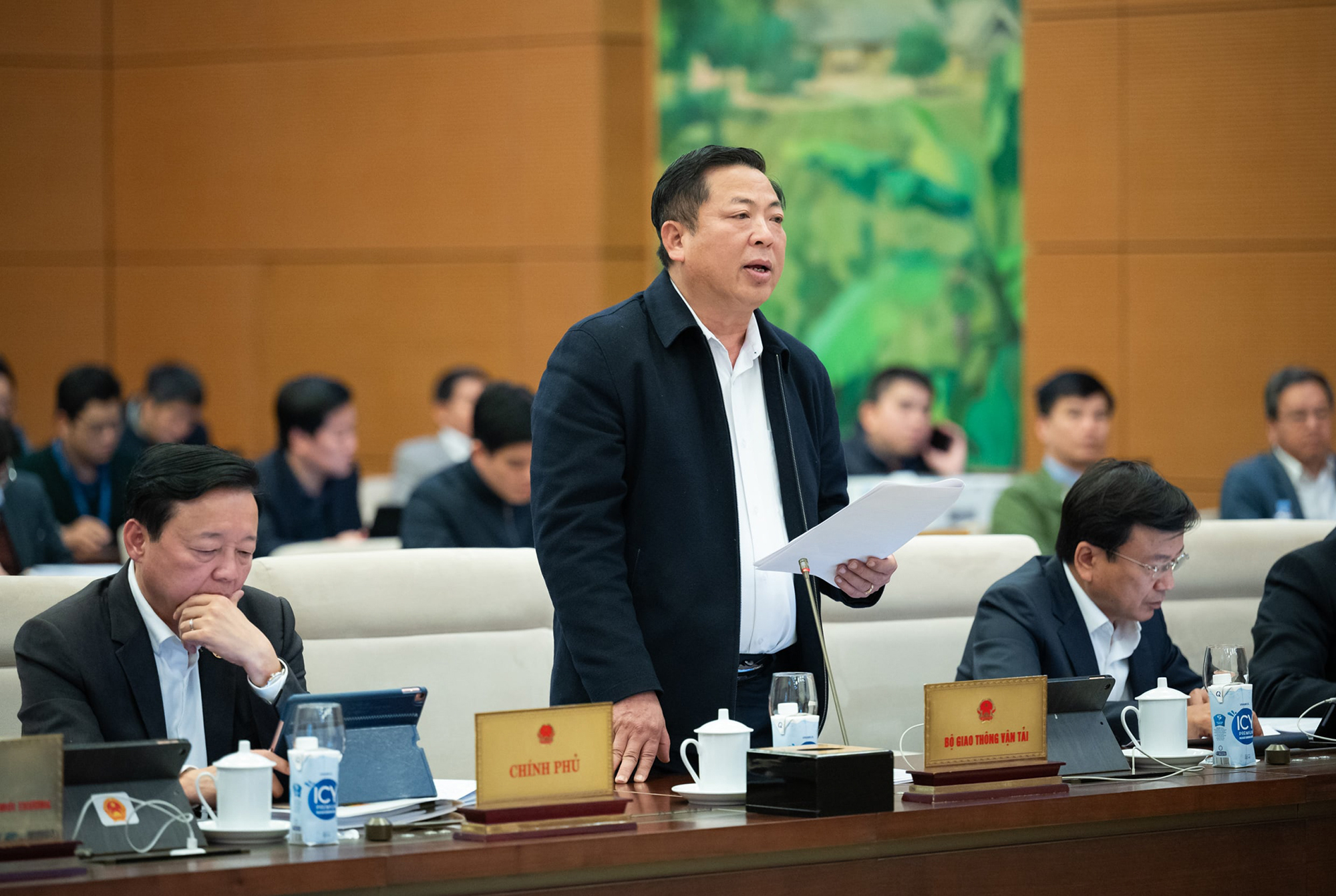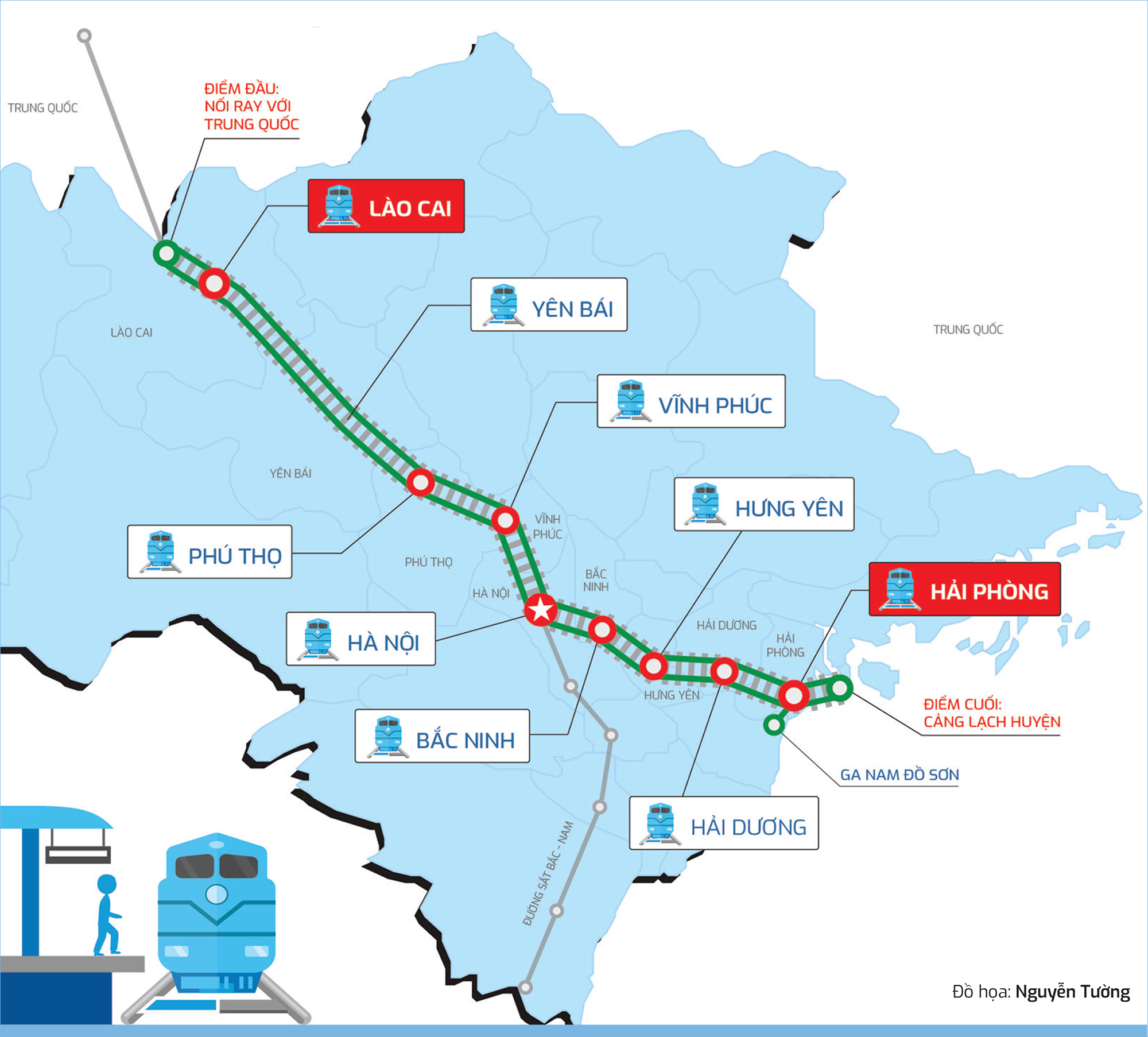The route, when invested, will open up great opportunities for transportation, international connections, and reduce logistics costs. For implementation, many specific mechanisms have been proposed.
Yesterday afternoon (10/2), the National Assembly Standing Committee gave its opinion on the investment policy of the Lao Cai – Hanoi – Hai Phong railway with a gauge of 1,435mm.
The shortest route, as straight as possible
Presenting the Government’s report, Minister of Transport Tran Hong Minh said that the project has a starting point at the location of the cross-border rail connection between Lao Cai New Station and Ha Kou Bac Station (China), in the territory of Lao Cai City; the end point is at Lach Huyen wharf area, in Hai Phong City. The length of the main route is about 390.9km and 3 branch routes are about 27.9km.
Minister of Transport Tran Hong Minh presented the Government’s report on the investment policy of the Lao Cai – Hanoi – Hai Phong railway project.
The project passes through 9 provinces and cities including: Lao Cai, Yen Bai, Phu Tho, Vinh Phuc, Hanoi, Bac Ninh, Hung Yen, Hai Duong, Hai Phong. Preliminary total investment is about 203,231 billion VND (about 8,369 billion USD).
The Government proposes that the funding sources for the project include the State budget (central and local), domestic capital, foreign capital sources (borrowing from the Chinese Government) and other legal capital sources.
Regarding the scale of investment, the construction of a new 1,435mm gauge electrified railway, transporting passengers and goods together; the main route from Lao Cai Moi station to Nam Hai Phong station has a design speed of 160km/h, the section through the Hanoi focal area has a design speed of 120km/h, and the connecting sections and branch routes have a design speed of 80km/h.
In terms of technology, the use of concentrated propulsion train technology for passenger and cargo trains; the information and signal system is equivalent to the system being used in a number of railways to transport passengers and goods in the region.
According to Minister Tran Hong Minh, the direction of the route is studied and selected to ensure the shortest and most straight possible, ensuring conformity with the plans approved by the competent authorities.
Regarding station works, it is expected to arrange 18 stations (including 3 train stations, 15 mixed stations). In the process of exploitation, when the demand for transportation increases, a number of technical operation stations will be researched and upgraded into mixed stations and additional stations will be invested when there is a need.
Regarding progress, according to the Government’s proposal, the project will be prepared a feasibility study report from 2025, striving to be basically completed by 2030.
Removing the “bottleneck” point of intermodal transport
As noted by PV in the first days of the new year, in the area of Vu Cach station (Hai Phong), the activity of queuing sulfur by train to China through Lao Cai border gate is still taking place regularly.
Direction of the Lao Cai – Hanoi – Hai Phong railway line with a gauge of 1,435mm according to the pre-feasibility study report
Mr. Duong Van Hung, Chairman of the Board of Directors and Director of Hai Phong Railway Transport Services Joint Stock Company – a railway transport leasing unit, said that this is a traditional item that the company undertakes services for Chinese partners. In addition to sulfur, there are also ores and other bulk commodities with a two-way output of about 350,000 tons/year.
Previously, sulfur and iron ore passed through Hai Phong port, from there by train through Lao Cai to Chinese factories and vice versa with higher output. However, about 10 years ago, when China built a 1,435mm gauge railway to Hekou Bac station near the border, output decreased because Vietnamese railways still used 1,000mm gauge.
Very few locomotives and 1,000mm wagons are eligible to run on Chinese railways, so most trains have to stop at Lao Cai station, transferring goods to Chinese wagons. At Hekou Bac Station, if you want to go deep into China, you have to transfer to a 1,435mm gauge car, incurring many operations and costs.
Before the information that the Lao Cai – Hanoi – Hai Phong railway was submitted to the National Assembly for investment policy, Mr. Nguyen Hoang Thanh, Deputy General Director of Railway Transport and Trading Joint Stock Company (Ratraco) said that this will help businesses save a lot of time and import and export costs.
Creating a construction market of more than 4.5 billion USD
According to Mr. Vu Hong Phuong, Director of the Railway Project Management Board, the East-West corridor (Hai Phong – Hanoi – Lao Cai) is a transport corridor passing through 9 localities, accounting for 21% of GDP, 25% of industrial parks across the country. This is the second most important transport economic corridor after the North-South corridor.
The investment in this railway line will create a construction market with a value of more than 4.5 billion USD, about 90,000 jobs during construction and about 2,500 long-term jobs.
At the same time, the line connects to Chinese railways, through railways to Yunnan, Tibet and connects to Europe. Vietnam’s exports will travel by rail through Lao Cai border gate and be transported on this railway.
According to Mr. Nguyen Ngoc Dong, former Deputy Minister of Transport, of the 7 railway routes, if the North-South route is characterized by outstanding passenger demand, the East-West route meets the urgent needs of freight transportation and connectivity. Vietnamese goods transported to Europe by rail cost reduced from 1/3 to nearly 1/2 compared to traveling by sea, the time is also shortened from 14-20 days.
Proposing a series of specific mechanisms
In order to be able to start the project at the end of 2025 under the direction of the Government, Mr. Vu Hong Phuong said that the Ministry of Transport has implemented many works simultaneously.
Specifically, in the process of studying and preparing a pre-feasibility study report, the Ministry of Transport also implements the contents in the step of making a feasibility study report; Negotiating a loan agreement for the project…
The Ministry of Transport has proposed a series of specific policies, including a group of policies related to promoting progress, such as the authority to approve, the authority to adjust projects, determine capital sources, allow the application of the contractor appointment mechanism for all steps that may affect the start time, etc.
Accordingly, the Ministry of Transport proposes 19 policy groups under the jurisdiction of the National Assembly. In particular, it is proposed to allow the application of 15/19 policies in Resolution No. 172/2024/QH15 of the National Assembly on the investment policy of the high-speed railway project on the North-South axis.
At the same time, it is proposed to add 4 groups of policies under the jurisdiction of the National Assembly. In which, investors are allowed to be appointed to bid for bidding packages of projects of national importance according to the provisions of Article 23 of the Law on Bidding.
Lessons learned from previous projects show that two factors that have a great impact on prolonging the project construction progress are land acquisition, compensation, and resettlement support (THD, DB, HTTDC) of localities and disagreements and conflicts in the economic contract relationship between the investor and the contractor.
In order to overcome these factors, the Ministry of Transport has proposed specific mechanisms in the work of Land Permits, Land Permits, and Land Permits such as: Preliminary design dossiers can be used (after the investment policy is approved by the National Assembly) to send to localities to prepare for the implementation of Land Permits, Land Plans, and Land Plans; Assign localities to be investors of THD, DB, HTTDC projects, implement immediately after the project is approved for investment policy (previously it had to be approved to be implemented THD, DB, HTTDC)…
Thorough evaluation to avoid risks
Presenting the verification report to the Government, Chairman of the National Assembly’s Economic Committee Vu Hong Thanh said that the Economic Committee agreed on the need to invest in the project with the political and legal bases and practical reasons stated in the Government’s report.
Regarding the direction of the route, the verification agency proposed that in the feasibility study step, the Government direct relevant agencies to carefully review and select the optimal route orientation plan to ensure the connection of the project with the national railway network, urban railways, and other transport systems.
The Economic Committee also proposed to evaluate the overall effectiveness of railway projects expected to invest and thoroughly evaluate the financial plan, impacts in the operation and exploitation of the projects to minimize future risks.
In order to ensure feasibility and effectiveness, it is very necessary for the Government to propose the National Assembly to allow the application of a number of specific mechanisms and policies.


